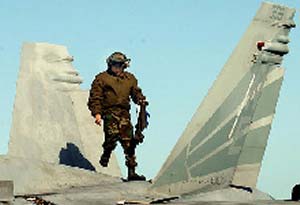Secretary of State Colin Powell said Wednesday,
in arguing the administration's case against
Saddam Hussein before the U.N. Security Council, that the time is approaching
for the world to declare "enough is enough."
U.S. forces have been assembling in the
Gulf region since December, including a seven-ship Navy fleet that entered
the Red Sea this week carrying about 7,000 Marines from the 2nd Marine
Expeditionary Brigade at Camp Lejeune, N.C. A similar size group of California-based
Marines is en route to the Gulf on seven other ships.
There are about 50,000 troops in Kuwait
and that number will climb further, officials said.
A senior defense official who is familiar
with U.S. military planning for possible war in Iraq said the Navy will
have six or seven aircraft carriers within striking distance of Iraq by
the end of this month. Three are within range now - the USS Harry S. Truman
in the Mediterranean Sea and the USS Abraham Lincoln and the USS Constellation
in the Persian Gulf or Arabian Sea - and a fourth, the USS Theodore Roosevelt
is en route.
If the Kitty Hawk went to the Gulf, the
USS Carl Vinson would replace it in the Pacific to maintain a carrier presence
within striking distance of North Korea, several defense officials said.
During the war in Afghanistan the Kitty Hawk operated in the Arabian Sea
with a contingent of special operations forces aboard. This time it would
be expected to play the more conventional role of launching air missions
over Iraq.
Mid-February is widely thought to be the
earliest date that U.S. forces would be ready to launch an invasion of
Iraq, but officials - all of them speaking on condition of anonymity -
said Wednesday that they may need some weeks beyond that. By early March,
the size of the U.S. force is likely to exceed 200,000 troops.
Also Wednesday, a veteran analyst of the
Iraqi military, Anthony Cordesman of the Center for Strategic and International
Studies, said in a new report that Iraq is building a two-ring defense
of Baghdad, the Iraqi capital. Iraq also is erecting an extensive structure
of barrier and other defenses in key cities, he wrote.
"There are also indications that some elements
of the Republican Guards may be training in urban warfare to fight in civilian
dress, and that Iraq will deliberately mix such loyalist elements, the
security services and popular forces in civilian dress to fight urban battles
under conditions where the U.S. and British may find it impossible to distinguish
combatants from civilians," Cordesman wrote.
There is no reliable estimate of Iraq's
exact military strength, Cordesman said. He estimates there are 389,000
full-time active duty troops, 2,200 to 2,600 battle tanks, 3,700 other
armored vehicles, 2,400 major artillery weapons and 300 combat aircraft.
He estimates Iraq has 850 surface-to-air missile launchers and about 3,000
anti-aircraft guns.

|
